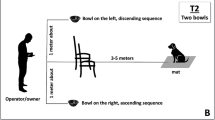Abstract
In a two-lever, food-reinforced drug-discrimination paradigm separate groups of rats were trained to discriminate either arecoline, pilocarpine or oxotremorine from saline. The discriminative cues of all three agonists were potently blocked by scopolamine, but only by 30–60 fold higher doses of methylscopolamine. The three agonists all suppressed overall response rate. These rate-suppressant effects were not blocked by scopolamine in doses which blocked the discriminative cues. In generalization tests, arecoline elicited selection of the drug-appropriate lever in all groups of trained animals. Pilocarpine was discriminated as drug by all pilocarpine-trained animals and by a majority of oxotremorine-trained animals, but was not significantly discriminated by the arecoline-trained group. Oxotremorine was discriminated by all oxotremorine-trained animals but only by some pilocarpine-trained animals, and was not significantly discriminated by the arecoline-trained group. Morphine, haloperidol, chlordiazepoxide, pentobarbital and nicotine were not generalized to any of the training drugs. The discriminative stimuli produced by the training drugs are therefore specific and exhibit properties indicative of an origin at central muscarinic receptors but may not be identical.
Similar content being viewed by others
References
Ahlenius S, Larsson K (1985) Central muscarinic receptors and male rat sexual behavior: facilitation by oxotremorine but not arecoline or pilocarpine in methscopolamine pretreated animals. Psychopharmacology 87:127–129
Bowen DM, Smith CB, White P, Davison AN (1976) Neurotransmitter-related enzymes and indices of hypoxia in senile dementia and other abiotrophies. Brain 99:459–496
Bowen DM, Benton JS, Spillane JA, Smith CCT, Allen SJ (1982) Choline acetyltransferase activity and histopathology of frontal neocortex from biopsies of demented patients. J Neurol Sci 57:191–202
Brinkman SD, Gershon S (1983) Measurement of cholinergic drug effects on memory in Alzheimer's disease. Neurobiol Aging 4:139–145
Chance WT, Murfin D, Krynock GM, Rosecrans JA (1977) A description of the nicotine stimulus and tests of its generalization to amphetamine. Psychopharmacology 55:19–26
Colpaert FC, Niemegeers CJE, Janssen PAJ (1975) The narcotic cue: evidence for the specificity of the stimulus properties of narcotic drugs. Arch Int Pharmacodyn Ther 218:268–276
Colpaert FC, Rosecrans JA (1978) Stimulus properties of drugs: 10 years of progress. Elsevier North Holland, Amsterdam
Davies P (1983) Neurochemical aspects of Alzheimer's disease. TIPS [Suppl] 4:98–99
Drachman DA (1982) Aging and dementia: insights from the study of anticholinergic drugs. In: Katzman R (ed) Biological aspects of Alzheimer's disease. Banbury Reports, vol 15. Cold Spring Harbor Laboratory, Cold Spring Harbor, New York, pp 363–369
Drachman DA, Sahakian BJ (1980) Memory and cognitive function in the elderly: a preliminary trial of physostigmine. Arch Neurol 37:674–675
Extance K, Goudie AJ (1981) Inter-animal olfactory cues in operant drug discrimination procedures in rats. Psychopharmacology 73:363–371
Herz A, Holzhauser H, Teschemacher H (1967) Central nicotine-and muscarine- like properties of cholinomimetic drugs with regard to their lipid solubility. Ann NY Acad Sci 142:21–26
Meltzer LT, Rosecrans JA (1981) Discriminative stimulus properties of arecoline: a new approach for studying central muscarinic receptors. Psychopharmacology 75:383–387
Overton DA (1974) Experimental methods for the study of state-dependent learning. Fed Proc 33:1800–1813
Overton DA (1982) Comparison of the degree of discriminability of various drugs using the T-maze drug discrimination paradigm. Psychopharmacology 76:385–395
Perry EK, Gibson PH, Blessed G, Perry RH, Tomlinson BE (1977) Neurotransmitter enzyme abnormalities in senile dementia. J Neurol Sci 34:247–265
Salamone JD, Lalies MD, Channell SL, Iversen SD (1986) Behavioural and pharmacological characterization of the mouth movements induced by muscarinic agonists in the rat. Psychopharmacology 88:467–471
Schechter MD, Rosecrans JA (1972a) Atropine antagonism of arecoline-cued behavior in the rat. Life Sci 11:519–523
Schechter MD, Rosecrans JA (1972b) Effect of mecamylamine on discrimination between nicotine- and arecoline-produced cues. Eur J Pharmacol 17:179–182
Siegel S (1956) Nonparametric statistics for the behavioral sciences. McGraw-Hill, New York London
Stolerman IP, Garcha HS, Pratt JA, Kumar R (1984) Role of training dose in discrimination of nicotine and related compounds by rats. Psychopharmacology 84:413–419
Stolerman IP, Shine PJ (1985) Trends in drug discrimination research analysed with a cross-indexed bibliography, 1982–1983. Psychopharmacology 86:1–11
Visscher FE, Seay PH, Tazelaar AP Jr, Veldkamp W, Vanderbrook MJ (1954) Pharmacology of Pamine bromide. J Pharmacol Exp Ther 110:188–204
Author information
Authors and Affiliations
Rights and permissions
About this article
Cite this article
Jung, M., Costa, L., Shearman, G.T. et al. Discriminative stimulus properties of muscarinic agonists. Psychopharmacology 93, 139–145 (1987). https://doi.org/10.1007/BF00179923
Received:
Revised:
Issue Date:
DOI: https://doi.org/10.1007/BF00179923




